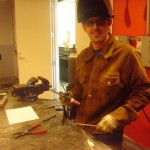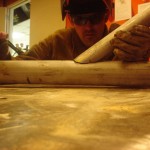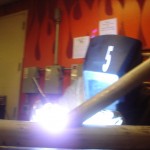Aug 31 2009
Getting knocked-up and knocked-down
Over the last five hundred years or so, if a sailor did something stupid like neglect his duties or disobey orders or insult his captain, or strike an officer, or desert the ship, or display rank incompetence or drunkenness or insubordination, or steal a dram of rum, or spit on the deck, or fail to stow his things properly or to clean his clothes adequately, there were any number of punishments that could be meted out: the sailor could be flogged, or whipped, or pickled, or cobbed, or made to run the gauntlet or to clean the head or to carry a 30-pound cannonball around the deck all day or to station himself at the top of the mast for a few hours or just to stand still until told otherwise. He could be lashed on board every ship in the fleet, or he could be tied to the mast for a week, or keel-hauled, or he could have had his feet bound and covered in salt and presented to goats for licking, which quickly went from ticklish to agonizing, because the goats don’t stop licking before the sailor’s feet have become bloody stumps. Or, if the sailor had mutinied or murdered, he could be hanged, shot, or have his head cut off, boiled, and then shoved onto a spike above decks, and left there for a week or so, to serve as an example to the remaining and hopefully far more loyal crew. Magellan preferred this latter technique. If the sailor had buggered (aka sodomized) another sailor, that, too could earn him the severest punishments. The sea was not San Francisco, man. But, if the sailor, while meeting the locals on some tropical island far away from home, knocked up a local woman, or a bunch of local women: nothing. Getting a girl knocked up was what sailors did when they weren’t sailing, like Genghis Khan, or Mulai Ismail, the last Sharifian emperor of Morocco, who had something like 1400 sons and daughters before he died. Most sailors probably never knew how many women they knocked up on their voyages.
How far we’ve come since those days. I can neglect my duties all I want; I can make fun of Matt’s mom and call Jon a cabron and not get punched in the face; I can run off to Yosemite for a couple of weeks; I can trim the sails poorly and sail us home by some unimaginably indirect course; we can get so drunk that we decide to clean up our spilled wine with spilled beer; I can drink all of Matt’s beer and Jon’s expensive whiskey; I can spit on the deck or anywhere else on the boat I feel like it; and I’m not sure if I’ve ever stowed my things or washed my clothes properly. The boat is my oyster. If I were so inclined, I could invite over all the gay guys in the bay area with one simple Craiglist post; instead, I have tried my hand at luring girls here, all the while wondering what girl would really find this sailboat alluring. Remember: according to Google, Syzygy is a janky piece of shit, and based on the information in this paragraph (swearing, drinking, spitting, dirtying), I’m no example of fine manners, either. Finally, the biggest change of all: getting girls knocked up is decidedly not what sailors do. This is the 21st century, man, even if it is San Francisco.
So I’m 31, and dating, and it’s always a mystery when and how to tell girls about the boat. They always have a ton of questions. Is it small? It’s like a New York City apartment, you know, a 400-square-foot studio. Is there a fridge, and a stove? Yup. Is there any headroom? I can’t jump up and down, but I don’t have to squat. Is there a bathroom? Yup, but I prefer to piss in the bay. Is it noisy? Seagulls squawk in the morning, and sometimes the wind howls in the afternoons, and sometimes the docklines creak as they stretch taut. I try to make it sound romantic. Does it rock back and forth? The boat moves a little bit when tied up, but nothing crazy. And get this: the boat is so burly that if it gets knocked over 90-degrees it still pops right back up. In fact, if it gets knocked over 120-degrees, it still pops right back up. Do you get seasick? Not in the marina, but at sea, sure. Most sailors do occasionally. Is it cold? Not really, and I have a diesel heater. Sometimes I feel like a caveman, proving that I exist in modern times: yes, I have electricity and laundry and cell-phone service and an internet connection. Yes, a sailboat. Really, it’s not a big deal. It’s got a certain allure, I know it, but somehow I end up on the defensive.
And here’s how I can tell my dating life isn’t going so well: I’m sleeping with Bob Seifert. Not “sleeping with” in the euphemistic sense, but literally, as in sleeping beside the book he wrote, called “Offshore Sailing: 200 essential passagemaking tips.” I have a hardcover copy of it in my bed, and I cuddle up to it every night like it’s some titillating classic or a book of translated swooning poems. Page 27 describes one of my favorite projects: boom preventers. As if I need those. There’s no other way to put it: it’s my boat porn, full of seacocks and cockpits and blowers and interfacing electronics and deep-cycle batteries and coupling nuts and prop shafts and large tools and lubricants and docking equipment and proper bedding techniques. Talk about a change. I should be punished for my behavior.




